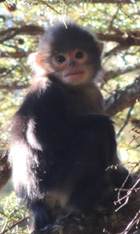Get
To Know
|
 The Myanmar Snub-Nosed Monkey is mostly black, with
protruding white ear tufts, a mostly naked face with pale pink skin,
a "moustache" of whitish hairs above the upper lip, and a distinct
white chin beard. The lips are prominent, and the nose upturned,
allegedly causing the animal to sneeze in rainy weather. As an adult
male, it has a length of 55.5 centimetres, and a tail 78 cm long.
They spend their summer months in northern Burma and China in temperate
mixed forests at upper altitudes of their range, and descend to
lower ground in the winter to escape snow. The species is known
in local dialects of Lisu people as mey nwoah and Law Waw people
as myuk na tok te, both of which mean "monkey with an upturned face,"
and when first discovered in 2010, they only were known to live
in three or four groups of 260 to 330 individuals within a 270 square
kilometres range at 1,700 to 3,200 metres above sea level in the
eastern Himalayas, in the north-eastern section of Kachin State,
the northernmost part of Burma. In 2011, a small population of a
hundred was discovered in Lushui County, Yunnan, China in the Gaoligongshan
National Nature Reserve. The species is isolated from other snub-nosed
Rhinopithecus by the Mekong and the Salween rivers; the other 4
species, golden, black, gray and Tonkin snub-nosed monkeys, are
found in China and Vietnam. The snub-nosed group of monkeys diverged
from other Asian monkeys about 6.8-6 million years ago, and from
Nasalis and Simia clade about 1.2 Ma. Various species of the snub-nosed
group split from each other about 730,000-400,000 years ago. It
is recognized as critically endangered by the IUCN; its unique appearance,
behaviour and vulnerability make it outstanding in conservation
issues, but it is seriously threatened by hunting and wildlife trade,
illegal logging and forest destruction linked to hydropower schemes
and associated infrastructure development.
The Myanmar Snub-Nosed Monkey is mostly black, with
protruding white ear tufts, a mostly naked face with pale pink skin,
a "moustache" of whitish hairs above the upper lip, and a distinct
white chin beard. The lips are prominent, and the nose upturned,
allegedly causing the animal to sneeze in rainy weather. As an adult
male, it has a length of 55.5 centimetres, and a tail 78 cm long.
They spend their summer months in northern Burma and China in temperate
mixed forests at upper altitudes of their range, and descend to
lower ground in the winter to escape snow. The species is known
in local dialects of Lisu people as mey nwoah and Law Waw people
as myuk na tok te, both of which mean "monkey with an upturned face,"
and when first discovered in 2010, they only were known to live
in three or four groups of 260 to 330 individuals within a 270 square
kilometres range at 1,700 to 3,200 metres above sea level in the
eastern Himalayas, in the north-eastern section of Kachin State,
the northernmost part of Burma. In 2011, a small population of a
hundred was discovered in Lushui County, Yunnan, China in the Gaoligongshan
National Nature Reserve. The species is isolated from other snub-nosed
Rhinopithecus by the Mekong and the Salween rivers; the other 4
species, golden, black, gray and Tonkin snub-nosed monkeys, are
found in China and Vietnam. The snub-nosed group of monkeys diverged
from other Asian monkeys about 6.8-6 million years ago, and from
Nasalis and Simia clade about 1.2 Ma. Various species of the snub-nosed
group split from each other about 730,000-400,000 years ago. It
is recognized as critically endangered by the IUCN; its unique appearance,
behaviour and vulnerability make it outstanding in conservation
issues, but it is seriously threatened by hunting and wildlife trade,
illegal logging and forest destruction linked to hydropower schemes
and associated infrastructure development.
|
|
|
|
Bridge to Future Out
by
Matt Morris
Taking shelter, Bob listens, supine
on a stone bed, as rain slows
overhead traffic to a crawl.
He scarfs down the last of the cheese
crackers, sees the downcast,
downsized Keebler elves, the once leafy Hollow Tree
depicted on the wrapper
just another empty
shell of industry. Our president, the paper
notes, is noticeably gay. Meant to
say gray. Meant to say, but never bothered to run
the ho-hum retraction, never mentioned his pen-
chant for guns & hookers, the available photos
unprintable, so elects to show him propped
behind the podium to herald the opening
of a nuclear plant, his puppet hand up-
raised, canvassing the bloom
before it's inevitably off the economy,
the boom ever coming, everywhere
save here. Isn't it sad that Bob projects
his loss onto cartoon depictions
of factory workers? That since
he got the axe, so does the symbolic
tree? Doesn't it seem
odd for a grown man to incorporate
elves into his fantasies? Aren't they the product
of another's daydream, an ad man,
say, who, years ago, on a gin jag,
desperate to keep his job, pitched higher-
ups the proletarian elves'
concept that he'd, nervously lighting
a Kool, filched from a matchbook
bidding him to draw, what, a leprechaun? Isn't he currently
working for the White House? If so, who's
really surprised? Rain tap dances
all around, somber thunder rumbas. Signs
point to overseas troop deployment favorably
impacting unemployment. Plenty hungry,
plenty drunk, Bob licks the cheesy
stains off his fingers. Lemmings forge
blindly ahead. The radio, ditto the chamber
of commerce, urges all
traffic not to exit, but to play it
smart & drive on.
Matt Morris is the author of Nearing Narcoma, winner of the Main
Street Press Poetry Book Award, and Walking in Chicago with a Suitcase
in My Hand, published by Knut House Press. His work has appeared in
various magazines and anthologies.
|
 Myanmar
Snub-Nosed Monkey -
Issue Thirty-Two
Myanmar
Snub-Nosed Monkey -
Issue Thirty-Two